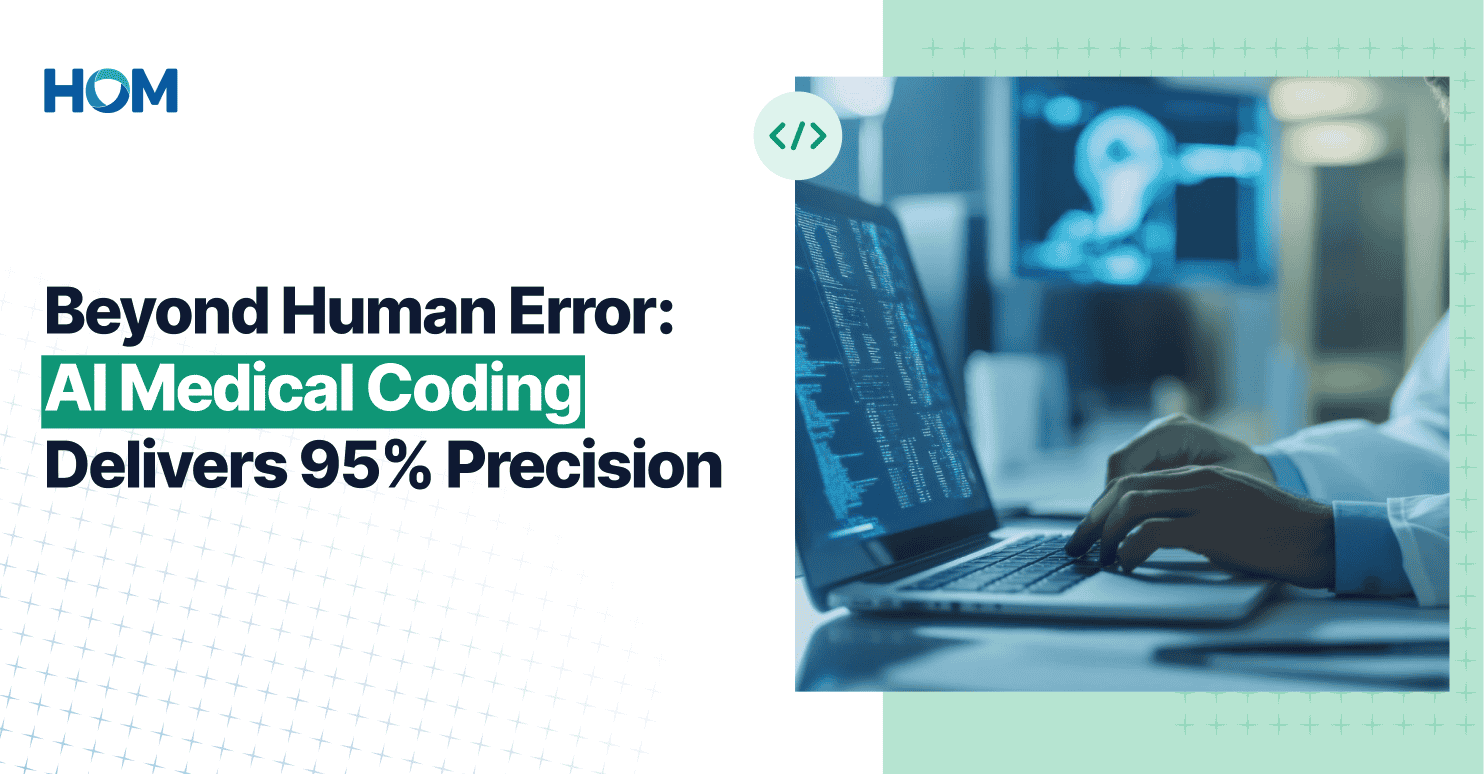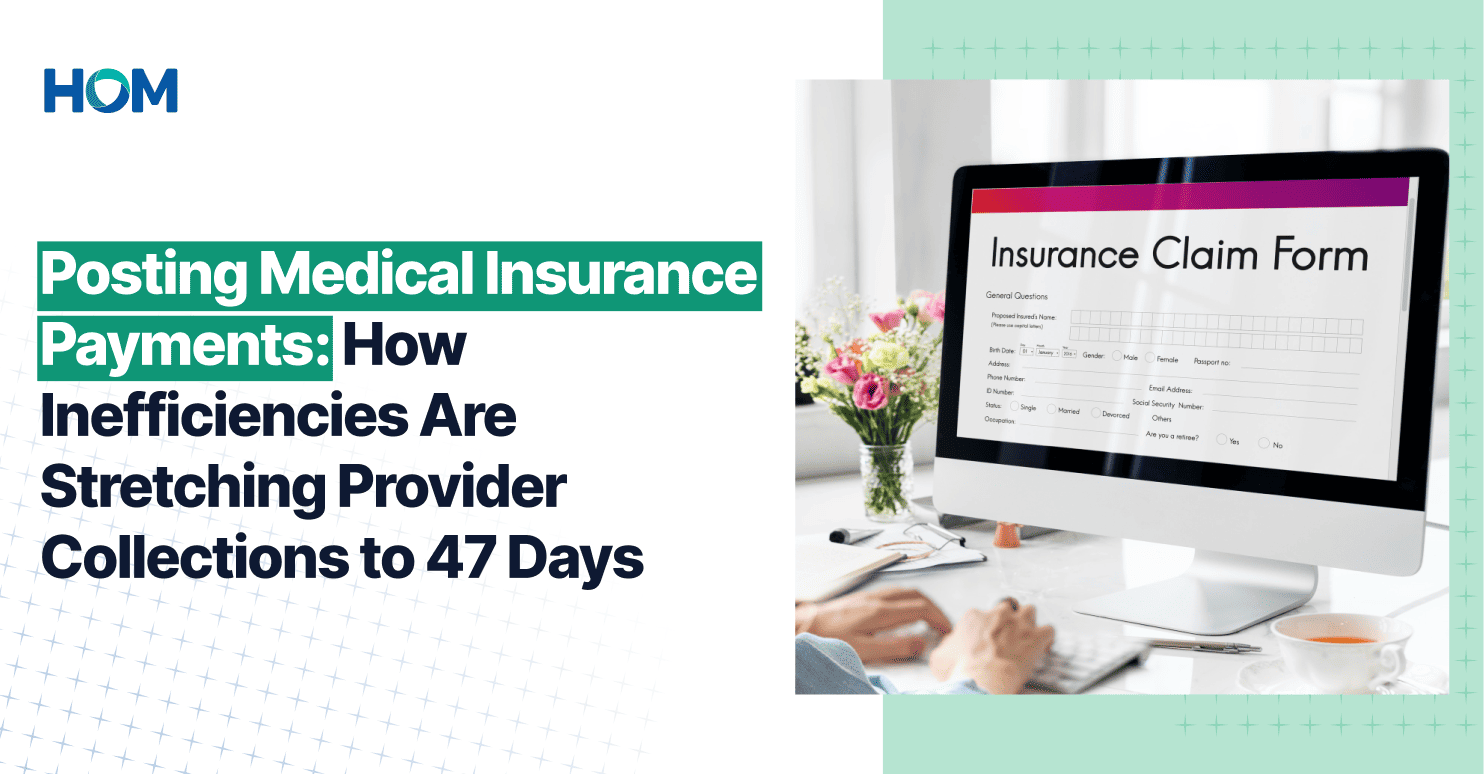
A single misplaced modifier or missed diagnosis code in medical coding can result in claim denials, compliance issues, and significant revenue loss. Additionally, documentation gaps lead to compliance investigations, whereas systematic undercoding results in millions of dollars in lost revenue annually.
These aren't isolated incidents. They represent systemic challenges within traditional coding methodologies that manual processes simply cannot address at the scale and complexity required by modern healthcare.
However, organizations implementing AI-assisted coding solutions, such as HOM’s, are consistently achieving 95% accuracy rates across diverse medical specialties. This represents a transformative shift in how healthcare revenue cycle management can operate when human expertise combines strategically with advanced technology.
In this blog post, let’s take a closer look.
Manual Coding: Limitations Providers Face
Traditional medical coding relies heavily on human interpretation of clinical documentation, a process that inherently carries variability and risk.
Despite their best efforts and abilities, even the most skilled AHIMA/AAPC-certified coders face challenges when dealing with the intricate requirements across medical specialties, each with its own coding nuances and regulatory frameworks.
Consider the breadth of specialties that require expert-level coding knowledge. For instance, cardiology procedures such as ECGs, echocardiograms, and catheterizations require different coding approaches than orthopedic fracture repairs or oncology chemotherapy administration.
On the other hand, neurology stroke management coding differs significantly from gastroenterology endoscopy procedures, and obstetrics coding presents entirely different challenges from dermatology excisions.
The cognitive load of maintaining expertise across these diverse areas while ensuring compliance with constantly evolving regulations creates inevitable pressure points where errors occur. These aren't failures of competence—they're natural limitations of human-only processes attempting to manage exponentially increasing complexity.
How AI-Assisted Coding Works
AI-assisted coding solutions operate on three fundamental principles that address the core limitations of manual processes:
Real-time Coding Assistance
The AI system provides immediate guidance during the coding process, helping coders navigate complex decision trees and identify optimal code selections based on documentation specificity. This isn't about automation—it's about augmentation, where technology amplifies human expertise rather than replacing it.
Continuous Compliance Monitoring
Every coding decision undergoes real-time validation against current regulatory requirements, helping ensure adherence to CMS guidelines, local coverage determinations, and payer-specific requirements. This proactive approach prevents compliance issues before they occur.
Pattern Recognition and Learning
The system continuously analyzes coding patterns, identifies opportunities for improvement, and learns from audit results and payer feedback. This creates a feedback loop that improves accuracy over time.
Scaling Across Medical Specialities
HOM’s experience across 15+ medical specialities reveals consistent patterns of improvement when AI assistance is properly integrated with human expertise.
- Cardiology: Complex procedures like catheterizations and stent placements require understanding of anatomical specificity, procedure combinations, and the intricate billing relationships between diagnostic and therapeutic interventions.
- Orthopedics: Fracture coding demands precise anatomical knowledge, understanding of surgical approaches, and accurate capture of hardware placement and removal procedures.
- Oncology: Cancer treatment coding requires knowledge of staging, treatment protocols, and the specific billing requirements for chemotherapy administration and radiation therapy.
- Neurology: Neurological procedures like EEGs and stroke management require understanding of diagnostic criteria, treatment protocols, and the billing implications of various interventions.
In each specialty, AI systems maintain specialized knowledge that complements coder expertise, resulting in more accurate and complete coding decisions.
The Operational Impact: Volume and Speed
- HOM’s medical coding approach has enabled the processing of up to 1.5 million charts while maintaining the 95% accuracy standard.
- This scale demonstrates that precision and efficiency aren't mutually exclusive; when properly implemented, AI assistance can improve both simultaneously.
- The system consistently delivers 48-72 hour turnaround times, enabling healthcare organizations to maintain rapid claim submission cycles while ensuring coding accuracy.
This speed-accuracy combination directly impacts cash flow, reducing the time between service delivery and reimbursement.
Quality Assurance Through Human-AI Partnership
The 95% accuracy achievement isn't the result of automation but of strategic human-AI collaboration.
HOM’s approach recognizes that the most complex coding decisions require human judgment, clinical knowledge, and contextual understanding that AI cannot replicate.
- Coder Expertise Enhancement: Rather than replacing coders, AI assistance elevates their role to focus on complex decision-making, exception handling, and quality assurance. Routine pattern recognition and compliance checking are handled by AI, freeing human expertise for higher-value activities.
- Continuous Learning Integration: The system learns from coder decisions, audit results, and payer feedback, creating a continuous improvement cycle that benefits both AI accuracy and human expertise development.
- Specialty-Specific Optimization: Different medical specialties require different approaches to AI training and implementation. HOM’s system maintains specialized knowledge bases that reflect the unique requirements of each specialty area.
Takeaway
The healthcare industry continues to evolve, with new regulations, coding updates, and reimbursement models creating ongoing challenges for revenue cycle management. AI-assisted coding provides a framework for adapting to these changes while maintaining the accuracy and compliance that healthcare organizations require.
For healthcare organizations ready to move beyond the limitations of manual coding processes, the path forward is clear: embrace AI assistance while maintaining the human expertise that ensures clinical accuracy and regulatory compliance.
The result is not just improved coding accuracy but a transformation in how healthcare organizations approach revenue cycle management in an increasingly complex regulatory environment.
HOM has delivered class-leading 95% accuracy in medical coding for close to 8 years, helping healthcare providers, health systems, and payers optimize their revenue cycle operations. Our coding solutions combine advanced technology with AHIMA/AAPC-certified expertise to deliver measurable results across 15+ medical specialties.
Contact partnerships@homrcm.com to learn how advanced medical coding and AI can transform your organization's financial performance.
Bring a change to your Healthcare Operations
A partnership with HOM gives you an inherent:
Connect with our experts for a quick analysis and possibilities.

















